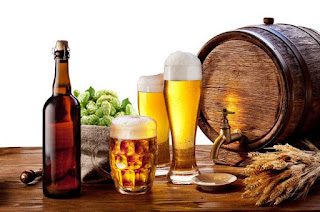 |
| Beer barrel with beer glasses |
The Effect of Fizz and Temperature on Beer Flavor
Two of the important attributes when dealing with carbonation which affects the beer flavor are the fizz produced by carbonation and the serving temperature. Higher the fizz, means higher C02, which tends to mask some of the delicate flavors of the beer, that result from its rich combination of malted grain, yeast and hops.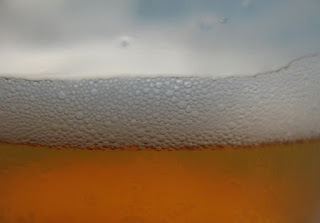 |
| Beer carbonation |
Carbonation in Draught Beer
Beer can be packaged in a bottle or a can or served from a cask or keg which is referred to as 'draught' beer, also spelled 'draft'. Cask and keg each has its own process of carbonating beer using natural or artificial carbonation methods.Traditionally beer has been conditioned in casks using a natural process of secondary fermentation which introduces C02 into the beer and gives it its bubbles. In the early 20th century, artificial process of carbonation was introduced as draught beer started to be served from pressurized containers called kegs. Each of these methods have its own advantages and disadvantages and importantly influence the flavor and mouthfeel of the beer.
Cask-conditioned Beer
Cask or barrel conditioned beer has been the oldest way for carbonating beer. Typically, unfiltered beer after the fermentation process, is added to the cask without any artificial carbonation. Yeast and priming sugar are added to the beer which starts a secondary fermentation process in the cask that produces C02.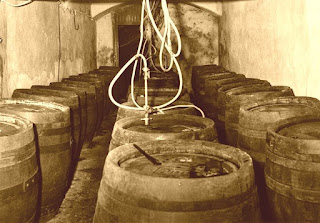 |
| Beer barrels at U Pinkasů restaurant cellar |
Brief History of Serving Cask-conditioned Beer
Beer can be served directly from the cask using the laws of gravity, where it simply flows out of the tap and into the glass. The invention of the beer engine, allowed the casks to be conveniently stored away from the bar counter, a practice followed by most pubs. |
| Serving draught beers with hand-pumps |
Joseph Bramah an Englishman best known for having invented the hydraulic press, further developed beer pumping towards the end of the 18th century.
The cask is typically located underneath the bar, and connected using a tube screwed onto the tap. The beer is served from the cask using a hand-pump, which causes the beer engine to draw the beer from the cask due to the vacuum pressure of air.
Flavor of Cask-conditioned Beer
The secondary fermentation that occurs in the cask-conditioned beer due to the addition of yeast and sugar produces a delicate carbonation, while slowly developing the flavor. As a result, cask-conditioned beer has less fizz or CO2 and a complex flavor profile due to the extended action of the yeast, the introduction of a little oxygen by the hand-pump and the period of maturation under cellar temperature. These conditions are often referred to as the hallmark of a properly and traditionally cellared beer and the essence of beer produced using natural processes. |
| Cask-conditioned beer |

Grains provide the flavor, color and aroma to the beer and good grain selection makes a good beer.
Due to the combination of lower fizz or C02, secondary fermentation by the yeast and higher serving temperature than force-carbonated beer, cask-conditioned ales have a smooth, creamy mouthfeel and a variety of subtle flavors from the malted barley, yeast and hops.
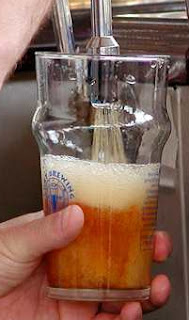 |
| Beer tap sparkler dispensing |
Disadvantages of Cask-conditioned Beer
Cask-conditioned beer has a shorter shelf life due to the presence of the yeast, and oxygen getting into the casks from the air pump, which make the beer stale after a period of time. Additionally, once the yeast has finished working on the sugar, they decompose and die giving the beer a sour taste.Due to the limited shelf life of cask-conditioned beer, pubs may not offer this option if they cannot sell their beer quickly.
Force-carbonated Beer
Due to the limited shelf life of cask-conditioned beer, force-carbonated beer became an alternative to the natural carbonation method for beer. It is an artificial method of carbonation as C02 is artificially or forcefully added to the beer.Force-carbonated beer is also referred to as keg beer and it is often filtered and/or pasteurized, both of which are processes that render the yeast inactive. This method of carbonation is called forced carbonation to distinguish it from the natural carbonation occurring in cask-conditioned beer.
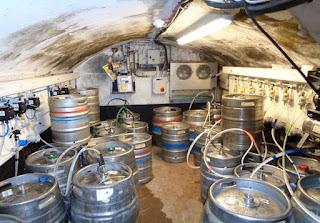 |
| Force-carbonated beer cellar |
When beer is carbonated with pressurized CO2, the carbon dioxide that is dissolved in the beer forms bubbles. These bubbles grow and accelerate as they rise by feeding of nearby smaller bubbles due to a phenomenon known as Ostwald ripening. These larger bubbles create a 'coarser' foam on top of poured beer.
Nitrogenated Beer
Beer is said to be nitrogenated when infused with a mixture of nitrogen gas and C02. This mixture is usually 70-75% nitrogen and 25-30% CO2.Nitrogen is less soluble in water than C02 hence it gives beer a different texture, stable, soft foam and a thicker, smooth mouthfeel due to its smaller bubbles.
Additionally, nitrogen beer taps are often fitted with a restrictor plate that both slows down the speed of the pour and also agitates the beer as it is poured, which causes the thick foam when the beer is poured. The combination of nitrogen and the restrictor plate also gives the beer its cascading bubble effect when poured from the beer tap, as the undissolved nitrogen escapes from the beer.
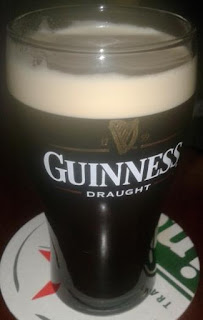 |
| Guinness beer |
Nitrogenated ales due to its lower proportion of C02 and its fuller and creamier mouthfeel provide an experience similar to the traditional cask ales without the risk of degradation due to oxidation.
Brief History of Force-carbonated Beer
Force-carbonated beer was introduced in the early 20th century in the United Kingdom. Watneys Red Barrel is said to be the first beer to be served from a pressurized container in 1931. Red Barrel was originally developed as an export beer that could be transported for long distances by sea, hence the beer was filtered to remove the yeast and pasteurized for stability.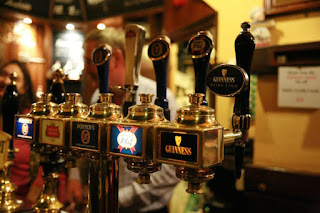 |
| Serving draught beers by taps |
Flavor of Force-carbonated Beer
Force-carbonated beer has a higher fizz due to its artificial carbonation process. It is also served at a lower temperature than cask-conditioned beer as the keg needs to be kept at a cooler temperature for the beer to absorb the gas. |
| Carbonated beer fizz |
Some part of the C02 combines with the beer to form carbonic acid. Highly carbonated beers can result in high carbonic acid which will alter the flavor of the beer and dramatically change its original flavor profile, coming across as more bitter and slightly sharper on the tongue.
Often letting a chilled highly carbonated beer, warm up a little before sipping, and swirling the glass to knock some of the C02 out, brings out some of the flavors of the beer ingredients.
 |
| Nitrogenated beer |
Though nitrogenated beers have traditionally been associated with the malt heavy ales and porters, in recent years they have also been experimented with other styles of beers. Nitrogenated beers complement the malt based ales and porters giving them a smooth and fuller mouthfeel but they can change the flavor and aroma of a strong styled IPA by hiding the bitter flavor from the hops.
Carbonation in Bottled or Canned Beer
Beer that is packaged in a bottle or can is also carbonated, either naturally or artificially.Bottle-conditioned Beer
The process of natural carbonation relies on secondary fermentation, by adding a little active yeast and sugar in the bottle at bottling time. Once the beer is bottled the yeast begins to act on the sugar creating C02 that is absorbed by the beer giving the beer its fizz. These beers are called bottle-conditioned beer and tend to have a deeper character and flavor, besides a natural, delicate carbonation.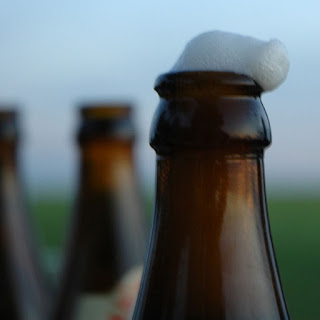 |
| Beer bottle fizz |
Artificially-carbonated Beer Bottle
Beer that is bottled using pressurized C02 gas is referred to as artificially-carbonated beer. In this method, the oxygen is first purged out of the bottle using C02, before filling it with the beer from the keg. The process uses a filler called beer-gun which has two separate lines for the gas and beer. The gas line is connected to a pressure controlled C02 tank and the beer line connects to the keg.Alternatively, a counter-pressure filler can also be used, in which case the bottle is flushed and then pressurized with carbon dioxide before filling with beer.
Most beer sold in bottles is artificially carbonated.
Nitrogenated Beer Can
Guinness packaged in a can relies on its proprietary nitrogen ball widget to create a smooth, creamier mouthfeel and long lasting foam.Guinness uses a nitrogen filled capsule that creates the bubbles and foam when the can is opened, due to the change in air-pressure, thereby replicating the draught experience in a can.
The Demand for Real Ale
Though artificially carbonated beer and nitrogenated beer is gaining popularity among brewers, many beer consumers argue that the production of beer must rely on natural brewing and cellaring processes and the flavor of the beer must highlight its key natural ingredients of malted grain, yeast, hops and water.Force carbonated and nitrogen-carbonated beers use C02 and nitrogen gases to introduce more fizz and longer shelf life for the beer using artificial means.
 |
| Real ale produced with cask-conditioning |
CAMRA defines 'real ale' as a natural product brewed using traditional ingredients and left to mature in the cask or bottle from which it is served, through a process of secondary fermentation.
Article Category: Drinks




No comments